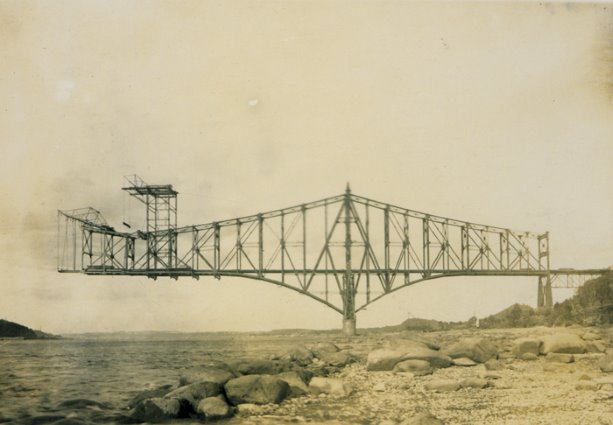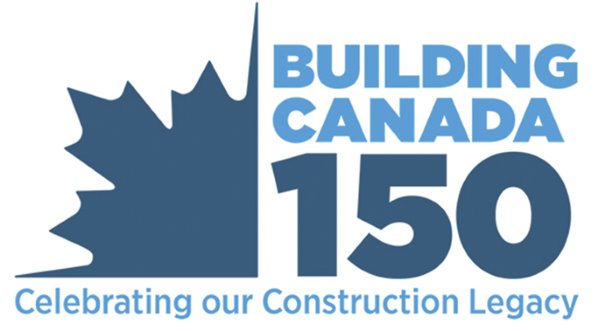This is the story of one bridge that endured two tragedies to become a reality.
The first cantilever bridge across the St. Lawrence River near Quebec City collapsed while under construction in 1907, with the loss of 75 lives. Another attempt at a very similar bridge at the same location was started in 1913. Then, when that bridge was nearing completion in September 1916, the centre span collapsed as it was being lifted into place, carrying 14 more people to their deaths.
The crossing was finally completed on Sept. 20, 1917. The following is a closer look at what happened during the first attempt to build the Quebec Bridge.
Bridging a Need
It has been noted that no bridge of any size collapses quickly. The process of designing and building — and doing it safely — takes years. The failure of a bridge can take just as long, although the final chaotic failure can take just minutes, even seconds.
The ultimate failure, the physical destruction of the Quebec bridge, is said to have taken no more than 15 seconds. The prelude took years. Early interest in bridging the river dates as far back as 1850, but gained no momentum until 1887. That’s when a group of local business leaders and politicians came together to form the Quebec Bridge Committee.
In 1903, the federal government began to vigorously promote the bridge project because it wanted to see the establishment of what it was calling the National Transcontinental Railway from Moncton to Winnipeg. Because the government considered the Quebec bridge a key part of that plan, it passed an act incorporating the Quebec Bridge Company with $1 million in capital and the power to issue bonds. It also guaranteed a bond issue of $6.7 million to pay for the bridge. So the Quebec Bridge Company, with money in its pocket and the prospect of more when needed, could go about building a bridge. But of course, there had been all sorts of background machinations dating back to 1897. That summer, a New York-based consulting engineer named Theodore Cooper attended the annual convention of the American Society of Civil Engineers in Quebec City. While there he visited the site where it was hoped a bridge would one day be built. And within a week he had sent a letter to the Quebec Bridge Company, offering his services. The offer was not unexpected. The company had been sounding out American bridge engineers as consultants because its own chief engineer, Edward Hoare, had never worked on a bridge with a span longer than about 90 metres.
The Quebec company had been in close touch with the Phoenix Bridge Company of Phoenixville, Pa. In fact, there was an aura of chumminess among most of the people involved in the project. The Phoenix company, for example, offered to prepare plans for the bridge free of charge. In return Quebec Bridge would then be obligated to award the construction contract to Phoenix Bridge.
Tenders for the project opened on Sept. 6, 1898, and remained open until March 1, 1899. The bids were then sent to Cooper for review.
Phoenix Bridge’s design, created by Peter Szlapka, the company’s chief designing engineer, called for a cantilever bridge 46 metres above the high water mark. There would be piers on each side of the river supporting anchor arms 152 metres long. They would be linked by a centre span of about 490 metres.
Cooper reported to Quebec Bridge that the plan as submitted by Phoenix was "the best and cheapest plan and proposal."
Who was Theodore Cooper?
Theodore Cooper was something of a prodigy, it seems, graduating from the school we now know as Rensselaer Polytechnic in 1858 at the age of 19. He enlisted in the Navy in 1861 and was engineer on a Union gunboat for the last three years of the Civil War. After the war he moved to a teaching position at the United States Naval Academy, then served a tour of duty in the South Pacific.
After resigning from the Navy in 1872 he joined Capt. James Eads, a well-known bridge engineer, working on a bridge in St. Louis. Cooper performed well, and rose quickly in his profession, working for the giant Keystone Bridge Company in Pittsburgh, then setting himself up as an independent consulting engineer in New York where he worked on a number of notable projects in Providence, R. I., Pittsburgh and New York.
The projects he worked on were prestigious, though none was a truly heroic masterwork. But since he was nearing retirement, it has been suggested that he undertook the Québec bridge as a signature, to sign off on his career.
Certainly something drove him to make decisions that, in retrospect, seem dubious from both an engineering and an ethical standpoint.
For example, five days before his formal appointment by Québec Bridge, he changed the length of the main span to 549 metres from 490 metres. He said it would enable the pieces to be constructed in shallower water and reduce construction time. But the authors of a case study published in 2006 in the Journal of Performance of Constructed Facilities noted that lengthening the main span would have made the finished bridge the longest cantilever bridge in the world.
Something else raised eyebrows: He failed to perform a recalculation of the bridge dead load when the centre span was lengthened.
Errors in Judgment
As work progressed workers and supervisors began finding noticeable midpoint deflections in some of the chords. When workers tried to rivet the joints between these chords the pre-drilled holes did not line up. As well, deflections were observed in some of the most heavily loaded compression members. Over time, the deflections increased.
All this was noted by workers and reported to Cooper and his on-site inspector, Norman McClure, in June 1907. Both men presumed that the deflections — still relatively small — could be attributed to some unknown pre-existing condition. Neither of them expressed alarm.
But a disturbing pattern was emerging. The members under highest compressive loads were gradually buckling. These were built up with latticing, and as they deflected, higher stresses were placed on the latticing as well as the rivets attaching the lattices to the main compression members.
Not happy with the explanation offered by his engineers, Cooper developed his own theory. It was stunningly simple. The deflected chords, he suggested, had simply been struck by suspended beams during the erection. But McClure investigated and found no evidence of such an incident.
Things got really tense in August, when it was found that the deflection of one chord increased to 57 millimetres from 19 millimetres in less than two weeks. The matching chord on the other side was bent in the same direction.
Finally, on Aug. 27 one of the construction foreman decided to halt work on the bridge until the problem could be solved. When word of that reached the Phoenixville office, project superiors there telephoned Québec saying it was safe to resume work on the bridge. In the meantime, Cooper and McClure were meeting in New York, both unaware that work had been resumed.
Then on Aug. 29, Cooper sent a telegram to the Phoenix office saying: "Add no more load to the bridge until after due consideration of facts. McClure will be over at 5 o’clock."
McClure was to stop at a telegraph office on his way back to Phoenixville to send a warning message to Québec, but, anxious to get back to Phoenixville himself, he forgot.
Phoenixville’s chief engineer arranged a meeting as soon as McClure arrived at about 5:15 p.m. The men discussed the situation briefly and decided to wait until morning to decide upon a course of action.
Just as they were ending their meeting the bridge collapsed at 5:30 p.m. The thunderous roar of the collapse was heard 10 kilometres away and the entire south half of the bridge fell into the waters of the St. Lawrence River.
After all the warning signs, after all the meetings, after all the decisions taken over the years, the actual collapse took about 15 seconds.
A Royal commission was formed to investigate the collapse. When its report was released in 1908, it found plenty of blame to be shared around among the engineers involved with the project. Most of it, however, was placed upon the shoulders of Cooper and Szlapka. It was Cooper, after all, who had examined and approved Szlapka’s design.
The commissioners wrote that "the failure cannot be attributed directly to any cause other than errors in judgment on the part of these two engineers…A grave error was made in assuming the dead load for the calculations at too low a value…This error was of sufficient magnitude to have required the condemnation of the bridge, even if the details of the lower chords had been of sufficient strength."
SIDEBAR
The devastating collapse of the Québec bridge in 1907 was followed quickly by a decision of the federal government that the project must proceed.
So the next year the minister of railways and canals appointed a board of engineers that arranged for and supervised the design and construction of a new bridge. They were starting pretty well from scratch. Except for the piers of the old bridge, nothing from the previous structure was recoverable.
Then, in April, 1911, a contract was awarded to the St. Lawrence Bridge Company. It was for another cantilevered bridge that it in appearance was very similar to the structure that had collapsed. It was different however in that the lower chords were several times stronger. It also would be made stronger by its use of what became known as a K-truss design, a feature that was conceived by Phelps Johnson, president and general manager of St. Lawrence Bridge.
Work began in 1913 and went well. By 1916 the bridge was almost finished.
All that remained was to hoist the centre span that would be connected each end to the cantilever arms.
The span had been prefabricated and was sitting in Sillery Cove, about 6 km from the bridge site.
On the morning of September 11, the span, carried on scows and moved by tugboat, was manoeuvred into position between cantilever arms. Two huge lifting hangers, attached to the ends of the arms slowly raise the span—up a bit at the north end then up a bit at the south. There were four successful lifts on the north end and five on the south when the workmen decided to take a break.
At 10:50 a.m., soon after the return to work, something went terribly wrong.
The southwest corner of the span tore away and began to sag. Seconds later the other end pulled off its support, the whole span came loose, and fell into the river below. Thirteen men were killed in the fall; several others were injured.
St. Lawrence Bridge quickly accepted responsibility for the failure, which originated with the casting in the erection equipment. Because no other part of the bridge was damaged, St. Lawrence Bridge immediately began work on a replacement span.
On Sept. 20, 1917, the replacement span was lifted into position and fastened to the cantilever arms.
The world’s longest cantilever bridge was finally completed and the first train crossed it in October.

1/2
Photo: MARTIN ST-AMANT/WIKIMEDIA COMMONS
2/2
The Quebec Bridge during construction in 1907 before its first tragic collapse. The bridge





Recent Comments
comments for this post are closed